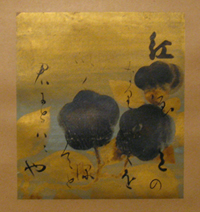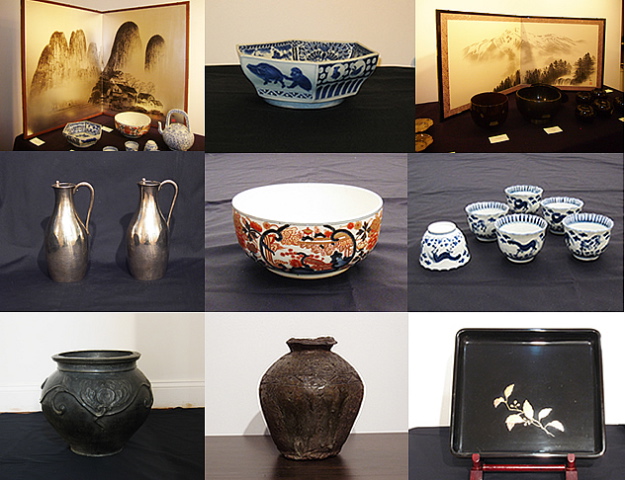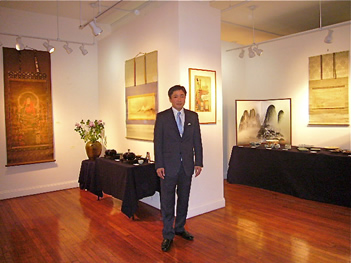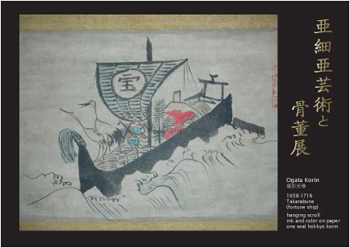| |
NY Coo Gallery in April presents its second antique exhibition entitled hAsian Art and Antique|Let There be Antique!h
Curated by Ryo Iida Asian Art, the exhibition features a wide range of Japanese antiques that are both visual and artistic treasure.
The highlight of the show is a painting by Ogata Korin (1658-1716), well respected painter of Rimpa School. The painting illustrates the image of takarabune (treasure ship). According to a popular belief started in Edo period, one will have a good dream by placing an image of takarabune under the pillow on New Yearfs Day, which will lead to the entire year with much fortune. The two cranes and pine trees on board are auspicious symbols of longevity. Hoju (sacred jewels) bring light into darkness. They also remove suffering and grant every wish. The large bales of rice are auspicious symbol of prosperity. The entire images are illustrated by Korinfs skillful brush work with light color. |
The other highlight is a shikishi (poem card) by Honfami Koetsu (1558-1637), who was one of the most versatile artists of his time, admired above all for his talent as calligrapher. His great achievement was to create a new style of calligraphy through a synthesis of the Chinese-influenced style with elements of the classical Japanese writing tradition of the Heian period (794--1185). A classic poem has been inscribed by Honfami Koetsu on this square sheet of paper decorated by Tawaraya Sotatsufs studio in gold and silver design of camellia. Now mounted as a hanging scroll, this is one of a set of similar poem pages probably intended to be pasted on a gold leaf screen. The poem, from his favorite anthology of Japanese court poetry, the Shinkokin wakashu (New Collection of Ancient and Modern Poetry Anthology).
It reads;
My tears turn into red marks on sleeve
You still donft notice me
How many more times I need to dye my sleeve with my tears
I wish I could ask my beloved man |
|
 |
| |
The show also includes screens, ceramic jars, porcelain dishes, and lacquer ware, metal-work and wood sculpture from 14th century to 20th century.
NY Coo Gallery |
| |
********** NY Coo Gallery News Letter - April **********
@@gAsian Art and Antique - Let There be Antique!h exhibition has finally began at the NY Coo Gallery.
Some of the main features of this antique exhibition include gTakarabuneh (treasure ship), a painting by Korin Ogata (1658-1716), as well as shikishi (poem card) by Koetsu Honfami.
The exhibition also displays screens, ceramic jars, porcelain dishes, lacquer ware, metal-work and wood sculpture from the 14th century to the 20th century.
Please join us and enjoy the beautiful, traditional Asian art.
|
 |
From top, left to right
Screen by Imai Takehisa (b. 1940) Landscape
Two panel screen, ink and silver on paper, signed Takehisa with one artistfs seal Takehisa / $400
Imari Blue and White, Hexagonal Shallow Bowl with Design of Zodiac Animals
Arita ware, Imari type, Edo Period, ca 1900 / $900
Screen by Imai Takehisa (b. 1940) Mt. Fuji
Two panel screen, ink and silver on paper, signed Takehisa with one artistfs seal Takehisa/ $500
Sterling Silver Chirori (sake decanter for cooling and warming)
First Half of 20th C. / $250 each
Imari Iroe (colored) Bowl
Edo Period, 19th C. $550
Imari blue and white cups with design of horse
Edo Period, First Half of 19th C. / sold (for set of six)
Satsuma Molded JarEdo Period
18th Century / $4000
Shigaraki Jar
Muromachi Period, 15th C. / $12,000
Black lacquer Tray with gold makie deco ration, with design of Manryo (Japanese Ardisla)
First half of 20th C. / $350
|
|

|
|
|
| |
|
|


